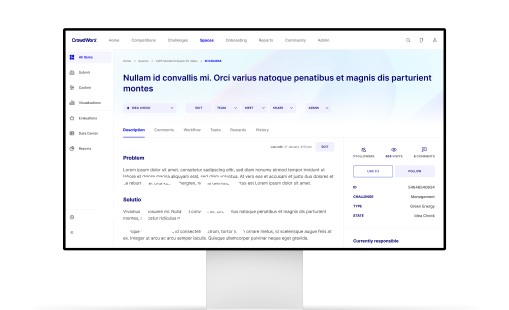Most corporate idea challenges fail to live up to expectations.
You launch with enthusiasm, send company-wide emails, and wait for brilliant solutions to flood in. Three weeks later, you’re staring at a handful of half-baked suggestions that quietly disappear into digital graveyards.
Employee disengagement costs organizations billions annually. Nearly 80% of employees worldwide remain disengaged at work, despite companies investing heavily in participation initiatives. The result? Missed opportunities, stagnant innovation, and talent walking out the door.
But idea challenges offer a proven solution when designed correctly. They tap into the collective intelligence of hundreds or thousands of people focused on solving what matters most to your organization.
At Crowdworx, we’ve seen the difference between challenges that generate genuine engagement and those that become expensive suggestion boxes. The gap comes down to design and execution – not luck or expensive technology.
Why Most Idea Challenges Fail
Between 40% to 90% of innovation projects fail to deliver on their promises. Innovation initiatives specifically show a 95% failure rate despite initial optimism and potential. What’s going wrong?
Strategic Misalignment Kills Participation
Strategic misalignment represents the most significant barrier to successful idea challenges. Without connecting the challenge to organizational objectives, participation remains lukewarm at best.
Organizations routinely launch challenges without establishing how the initiative supports broader business goals. This disconnect creates confusion among potential participants who struggle to understand why their contributions matter.
Consider the typical scenario: leadership announces an innovation challenge focused on “improving customer experience” while simultaneously implementing cost-cutting measures that restrict customer service resources. Employees see this contradiction and question whether their ideas will receive genuine consideration.
Resource Constraints Kill Momentum
For small and medium enterprises, resource limitations stand as the main cause of innovation failure. Without adequate funding, staffing, or technological support, even promising challenges collapse before gaining traction.
Money isn’t the only resource that matters. Time, skilled facilitators, and proper technology platforms all play critical roles. When organizations skimp on these essentials, participants notice immediately.
Getting the Audience Wrong
Many organizations make one of two mistakes: they either cast too wide a net, diluting focus and relevance, or restrict participation so severely that diverse perspectives never emerge.
You need enough people to generate diverse ideas, but not so many that the challenge becomes unfocused. You need participants who understand the problem deeply, but you also need fresh perspectives from outside the immediate area.
Culture Kills More Challenges Than Bad Technology
Cultural barriers at individual, team, or organizational levels prevent successful implementation of new ideas. The “not-invented-here” syndrome proves particularly destructive – this tendency to reject ideas from external sources accounts for 58.6% of cultural resistance in SMEs.
Without psychological safety and an innovation-friendly culture, people hesitate to contribute ideas. They fear criticism, career repercussions, or being labeled as troublemakers.
The Implementation Black Hole
Nothing damages participation more than ideas disappearing into an organizational black hole. Employees invest time and mental energy into contributing solutions, then watch them vanish without explanation.
Research shows that employees who have been part of ideation sessions are often frustrated because nothing substantive happens with the ideas they generate. Without transparent communication about evaluation processes and implementation progress, participants have no way to gauge their contribution’s impact.
The 7 Elements That Drive Participation
Successful idea challenges don’t happen by accident. Every high-performing innovation initiative follows a carefully designed framework that encourages widespread participation and generates quality contributions.
1. Crystal-Clear Strategic Alignment
Strategic alignment serves as the cornerstone of successful idea challenges.
How to achieve strategic alignment:
- Frame challenges around specific business problems, not vague prompts
- Connect each challenge explicitly to organizational goals or KPIs
- Ensure executive sponsorship to reinforce strategic importance
- Communicate how the challenge fits within broader innovation strategy
Instead of asking for “innovation in customer service,” effective challenges tackle specific problems: “How can we reduce customer onboarding time by 50% while maintaining quality?”
2. Defined Goals and Success Metrics
Every successful idea challenge begins with quantifiable targets that provide concrete aims for participants and organizers.
You need to establish at least one quantifiable goal, regardless of what solutions you’re seeking. This creates something concrete to aim for and establishes a baseline for measuring results.
Effective metrics include:
- Implementation rates
- Cost savings generated
- Revenue improvements
- Customer satisfaction increases
Clear objectives ensure team members understand the specific challenges they’re addressing and how their ideas align with organizational goals.
3. Smart Audience Selection
Finding the right balance between audience size, relevance, and reachability represents a critical success factor. The right ideas will only come from the right people.
The three-dimensional approach:
- Relevance – Connect with people who have necessary expertise or insight
- Size – Ensure sufficient participation to generate diverse perspectives
- Reachability – Have effective means to communicate and engage participants
Consider who “lives” the problem every day, who understands the constraints, and who has the creativity and context to propose viable solutions.
4. Transparent Rules and Evaluation Criteria
People don’t disengage because their ideas weren’t selected – they disengage because they never knew why.
Make evaluation criteria public from day one:
- Who will be evaluating submissions
- When evaluation will occur
- How feedback will be provided
- What happens after ideas are selected
Involve visible, respected evaluators to signal the challenge is being taken seriously. When leaders or subject matter experts participate in evaluation, it reinforces the challenge’s importance and builds credibility.
5. Timely Communication and Reminders
Effective communication serves as the lifeblood of successful idea challenges. A well-organized launch represents an extremely important success factor.
Be crystal clear about four key points:
- The purpose of the challenge
- Who should participate and why
- The timeline and important deadlines
- How ideas will be evaluated
Throughout the challenge, communicate significant news, maintain enthusiasm, and send reminders so those who intend to participate don’t accidentally forget.
6. Recognition and Reward Systems
People don’t innovate primarily for prizes – they do it to be seen, to grow, and to matter.
Effective recognition operates on multiple levels:
- Public acknowledgment – Showcase contributions in meetings or company communications
- Career advancement – Provide opportunities to lead pilots or co-create with teams
- Proportional rewards – Ensure rewards match value created
If someone invests significant time in an idea that delivers substantial value, recognition should extend beyond token gestures to include meaningful opportunities like mentorship, funding, and dedicated time to develop ideas.
7. Follow-Through and Implementation Visibility
Perhaps the most critical element for long-term engagement is demonstrating that submitted ideas actually go somewhere.
Essential implementation transparency:
- Provide regular updates on selected idea status
- Explain reasons for delays or adjustments
- Celebrate implementation milestones
- Document and share impacts and lessons learned
The more individuals see success of projects to which they have contributed, the more likely they are to remain engaged. This visible implementation creates a virtuous cycle where participants see tangible outcomes from their efforts.
Building Your High-Performing Challenge Framework
Successful idea challenges create environments where collaborative problem-solving flourishes naturally. The seven elements work together as an integrated system where each component reinforces the others.
Start with these fundamentals:
- Keep the process simple and remove friction from participation
- Track implementation progress and communicate outcomes regularly
- Focus on quick wins that demonstrate value early
- Secure visible executive sponsorship and ongoing support
- Target people who understand the challenge and can propose viable solutions
Avoid these common mistakes:
- Don’t launch during busy periods or holiday seasons
- Don’t overcomplicate evaluation with excessive approval steps
- Never collect ideas without a clear plan for implementation
People drive innovation success. Human connections, trust, and leadership commitment determine whether your challenge generates lasting impact.
Organizations that apply these principles consistently unlock the creative potential of their workforce. They turn scattered insights into systematic innovation that drives measurable business results.
Your next idea challenge can deliver meaningful outcomes. Focus on the fundamentals, start small, and build momentum through consistent execution.
At Crowdworx, we make running idea challenges simple and effective. With the built-in Campaign Wizard, managers can launch a new challenge in just a few minutes — whether it’s open to internal teams or external participants. The platform supports multiple campaigns running in parallel, complete with discussion and voting tools to keep engagement high. Results can be automatically exported as PPTX, DOCX, or XLSX reports, making it easy to share outcomes and recognize contributions. These features ensure that every idea challenge is structured, transparent, and designed for participation at scale.

